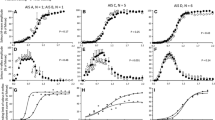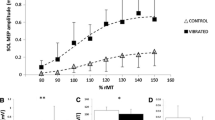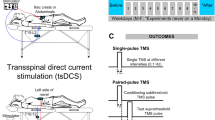Abstract
The afferent volley generated during neuromuscular electrical stimulation (NMES) can increase the excitability of the human corticospinal (CS) pathway. This study was designed to determine the effect of different frequencies of NMES applied over the common peroneal nerve on changes in CS excitability for the tibialis anterior (TA) muscle. We hypothesized that higher frequencies of stimulation would produce larger increases in CS excitability than lower frequencies. NMES was applied at 10, 50, 100, or 200 Hz during separate sessions held at least 48 h apart. The stimulation was delivered in a 20 s on, 20 s off cycle for 40 min using a 1 ms pulse width. The intensity of stimulation was set to evoke an M-wave in response to a single pulse that was 15% of the maximal M-wave. CS excitability was evaluated by the amplitude of motor-evoked potentials (MEPs) in TA evoked by transcranial magnetic stimulation. MEPs were recorded immediately before and after the 40 min of NMES and in each 20 s “off” period. For each subject, MEPs recorded during three successive “off” periods were averaged together (n = 9 MEPs), providing a temporal resolution of 2 min for assessing changes in CS excitability. When delivering NMES at 100 Hz, MEPs became significantly elevated from those evoked before the stimulation at the 24th min, and there was a twofold increase in MEP amplitude after 40 min. NMES delivered at 10, 50, and 200 Hz did not significantly alter MEP amplitude. The amplitude of MEPs evoked in soleus and vastus medialis followed similar patterns as those evoked simultaneously in TA, but these changes were mostly not of statistical significance. There were no changes in the ratio of maximal H-reflex to maximal M-wave in TA or soleus. These experiments demonstrate a frequency-dependent effect of NMES on CS excitability for TA and show that, under the conditions of the present study, 100-Hz stimulation was more effective than 10, 50, and 200 Hz. This effect of NMES on CS excitability was strongest in the stimulated muscle and may be mediated primarily at a supraspinal level. These results contribute to a growing body of knowledge about how the afferent volley generated during NMES influences the CNS and have implications for identifying optimal NMES parameters to augment CS excitability for rehabilitation of dorsiflexion after CNS injury.





Similar content being viewed by others
References
Barsi GI, Popovic DB, Tarkka IM, Sinkjaer T, Grey MJ (2008) Cortical excitability changes following grasping exercise augmented with electrical stimulation. Exp Brain Res 191(1):57–66
Brasil-Neto JP, Valls-Sole J, Pascual-Leone A, Cammarota A, Amassian VE, Cracco R, Maccabee P, Cracco J, Hallett M, Cohen LG (1993) Rapid modulation of human cortical motor outputs following ischaemic nerve block. Brain 116(Pt 3):511–525
Burke D, Kiernan MC, Bostock H (2001) Excitability of human axons. Clin Neurophysiol 112:1575–1585
Butefisch CM, Davis BC, Wise SP, Sawaki L, Kopylev L, Classen J, Cohen LG (2000) Mechanisms of use-dependent plasticity in the human motor cortex. Proc Natl Acad Sci USA 97:3661–3665
Celnik P, Hummel F, Harris-Love M, Wolk R, Cohen LG (2007) Somatosensory stimulation enhances the effects of training functional hand tasks in patients with chronic stroke. Arch Phys Med Rehabil 88:1369–1376
Chae J, Sheffler L, Knutson J (2008) Neuromuscular electrical stimulation for motor restoration in hemiplegia. Top Stroke Rehabil 15:412–426
Chen R, Corwell B, Hallett M (1999) Modulation of motor cortex excitability by median nerve and digit stimulation. Exp Brain Res 129:77–86
Classen J, Liepert J, Wise SP, Hallett M, Cohen LG (1998) Rapid plasticity of human cortical movement representation induced by practice. J Neurophysiol 79:1117–1123
Collins DF, Burke D, Gandevia SC (2002) Sustained contractions produced by plateau-like behaviour in human motoneurones. J Physiol 538:289–301
Conforto AB, Kaelin-Lang A, Cohen LG (2002) Increase in hand muscle strength of stroke patients after somatosensory stimulation. Ann Neurol 51:122–125
Dean JC, Yates LM, Collins DF (2007) Turning on the central contribution to contractions evoked by neuromuscular electrical stimulation. J Appl Physiol 103(1):170–176
Elbert T, Sterr A, Flor H, Rockstroh B, Knecht S, Pantev C, Wienbruch C, Taub E (1997) Input-increase and input-decrease types of cortical reorganization after upper extremity amputation in humans. Exp Brain Res 117:161–164
Fraser C, Power M, Hamdy S, Rothwell J, Hobday D, Hollander I, Tyrell P, Hobson A, Williams S, Thompson D (2002) Driving plasticity in human adult motor cortex is associated with improved motor function after brain injury. Neuron 34:831–840
Hess G, Donoghue JP (1994) Long-term potentiation of horizontal connections provides a mechanism to reorganize cortical motor maps. J Neurophysiol 71:2543–2547
Hoffman LR, Field-Fote EC (2007) Cortical reorganization following bimanual training and somatosensory stimulation in cervical spinal cord injury: a case report. Phys Ther 87:208–223
Kaelin-Lang A, Luft AR, Sawaki L, Burstein AH, Sohn YH, Cohen LG (2002) Modulation of human corticomotor excitability by somatosensory input. J Physiol 540:623–633
Khaslavskaia S, Sinkjaer T (2005) Motor cortex excitability following repetitive electrical stimulation of the common peroneal nerve depends on the voluntary drive. Exp Brain Res 162:497–502
Khaslavskaia S, Ladouceur M, Sinkjaer T (2002) Increase in tibialis anterior motor cortex excitability following repetitive electrical stimulation of the common peroneal nerve. Exp Brain Res 145:309–315
Kido TA, Stein RB (2004) Short-term effects of functional electrical stimulation on motor-evoked potentials in ankle flexor and extensor muscles. Exp Brain Res 159:491–500
Klakowicz PM, Baldwin ER, Collins DF (2006) Contribution of m-waves and h-reflexes to contractions evoked by tetanic nerve stimulation in humans. J Neurophysiol 96:1293–1302
Knash ME, Kido A, Gorassini M, Chan KM, Stein RB (2003) Electrical stimulation of the human common peroneal nerve elicits lasting facilitation of cortical motor-evoked potentials. Exp Brain Res 153:366–377
Kurusu K, Kitamura J (1999) Long-latency reflexes in contracted hand and foot muscles and their relations to somatosensory evoked potentials and transcranial magnetic stimulation of the motor cortex. Clin Neurophysiol 110:2014–2019
Ladouceur M, Barbeau H (2000) Functional electrical stimulation-assisted walking for persons with incomplete spinal injuries: longitudinal changes in maximal overground walking speed. Scand J Rehabil Med 32:28–36
Lagerquist O, Zehr EP, Baldwin ER, Klakowicz PM, Collins DF (2006) Diurnal changes in the amplitude of the Hoffmann reflex in the human soleus but not in the flexor carpi radialis muscle. Exp Brain Res 170:1–6
Liberson WT, Holmquest HJ, Scot D, Dow M (1961) Functional electrotherapy: stimulation of the peroneal nerve synchronized with the swing phase of the gait of hemiplegic patients. Arch Phys Med Rehabil 42:101–105
McKay D, Brooker R, Giacomin P, Ridding M, Miles T (2002a) Time course of induction of increased human motor cortex excitability by nerve stimulation. NeuroReport 13:1271–1273
McKay DR, Ridding MC, Thompson PD, Miles TS (2002b) Induction of persistent changes in the organisation of the human motor cortex. Exp Brain Res 143:342–349
Merletti R, Zelaschi F, Latella D, Galli M, Angeli S, Sessa MB (1978) A control study of muscle force recovery in hemiparetic patients during treatment with functional electrical stimulation. Scand J Rehabil Med 10:147–154
Pascual-Leone A, Cammarota A, Wassermann EM, Brasil-Neto JP, Cohen LG, Hallett M (1993) Modulation of motor cortical outputs to the reading hand of braille readers. Ann Neurol 34:33–37
Pascual-Leone A, Nguyet D, Cohen LG, Brasil-Neto JP, Cammarota A, Hallett M (1995) Modulation of muscle responses evoked by transcranial magnetic stimulation during the acquisition of new fine motor skills. J Neurophysiol 74:1037–1045
Pitcher JB, Ridding MC, Miles TS (2003) Frequency-dependent, bi-directional plasticity in motor cortex of human adults. Clin Neurophysiol 114:1265–1271
Prochazka A, Gauthier M, Wieler M, Kenwell Z (1997) The bionic glove: an electrical stimulator garment that provides controlled grasp and hand opening in quadriplegia. Arch Phys Med Rehabil 78:608–614
Ridding MC, Brouwer B, Miles TS, Pitcher JB, Thompson PD (2000) Changes in muscle responses to stimulation of the motor cortex induced by peripheral nerve stimulation in human subjects. Exp Brain Res 131:135–143
Ridding MC, McKay DR, Thompson PD, Miles TS (2001) Changes in corticomotor representations induced by prolonged peripheral nerve stimulation in humans. Clin Neurophysiol 112:1461–1469
Roy FD, Gorassini MA (2008) Peripheral sensory activation of cortical circuits in the leg motor cortex of man. J Physiol 586:4091–4105
Stefan K, Kunesch E, Cohen LG, Benecke R, Classen J (2000) Induction of plasticity in the human motor cortex by paired associative stimulation. Brain 123(Pt 3):572–584
Stefan K, Kunesch E, Benecke R, Cohen LG, Classen J (2002) Mechanisms of enhancement of human motor cortex excitability induced by interventional paired associative stimulation. J Physiol 543:699–708
Stefanovska A, Vodovnik L, Gros N, Rebersek S, Acimovic-Janezic R (1989) FES and spasticity. IEEE Trans Biomed Eng 36:738–745
Tamm AS, Lagerquist O, Ley AL, Collins DF (2009) Chronotype influences diurnal variations in the excitability of the human motor cortex and the ability to generate torque during a maximum voluntary contraction. J Biol Rhythms 24:211–224
Walton C, Kalmar J, Cafarelli E (2003) Caffeine increases spinal excitability in humans. Muscle Nerve 28:359–364
Ziemann U, Muellbacher W, Hallett M, Cohen LG (2001) Modulation of practice-dependent plasticity in human motor cortex. Brain 124:1171–1181
Acknowledgments
This work was supported by a grant from the Natural Sciences and Engineering Research Council of Canada. The authors also wish to express their gratitude to Mr. Alejandro Ley for his technical support.
Author information
Authors and Affiliations
Corresponding author
Rights and permissions
About this article
Cite this article
Mang, C.S., Lagerquist, O. & Collins, D.F. Changes in corticospinal excitability evoked by common peroneal nerve stimulation depend on stimulation frequency. Exp Brain Res 203, 11–20 (2010). https://doi.org/10.1007/s00221-010-2202-x
Received:
Accepted:
Published:
Issue Date:
DOI: https://doi.org/10.1007/s00221-010-2202-x




